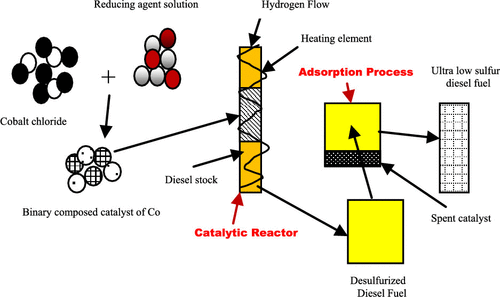当前位置:
X-MOL 学术
›
Ind. Eng. Chem. Res.
›
论文详情
Our official English website, www.x-mol.net, welcomes your
feedback! (Note: you will need to create a separate account there.)
New Approach for Catalytic Production of Ultralow-Sulfur Diesel Fuels Using Binary Composed Catalysts Consisting of Cobalt Nanoparticles
Industrial & Engineering Chemistry Research ( IF 3.8 ) Pub Date : 2020-03-19 , DOI: 10.1021/acs.iecr.9b06058 Ahmed M. A. El Naggar 1 , Hussien A. El Sayed 1 , Ahmed A. Salem 1 , Nour E. A. AbdEl-Sattar 2
Industrial & Engineering Chemistry Research ( IF 3.8 ) Pub Date : 2020-03-19 , DOI: 10.1021/acs.iecr.9b06058 Ahmed M. A. El Naggar 1 , Hussien A. El Sayed 1 , Ahmed A. Salem 1 , Nour E. A. AbdEl-Sattar 2
Affiliation

|
The global trend is orientated toward the production of diesel fuels composed of as low as 50 ppm (0.05 g/L) or even less sulfur compounds. As a result, the current study is orientated toward the generation of a diesel fuel with reduced sulfur content via the catalytic route. This research work introduces novel approaches in the catalytic desulfurization field through providing new perspectives. A special attention has been paid throughout this research toward the usage of advanced catalytic compositions in the sulfur removal application. Unlike the commonly known catalysts for the desulfurization processes that are basically metal oxides of different structures, catalysts with mixed structures are introduced in this study. Two novel cobalt catalysts based on metallic (zero-valent) and hydroxide structures were utilized to catalytically remove sulfur from the feedstock of the diesel fuel. The two catalysts were synthesized by the electroless deposition technique using two different reducers. The effect of these reducing agents on both the structure of the catalysts and their subsequent performance in the designated process was investigated. The diesel fuel manufactured in this study contains low content of sulfur; in addition to this, ultralow catalytic operational conditions had been other advances that have been concluded at the end of this work. Particularly, a temperature of 100 °C, liquid hour space velocity equals 1, and hydrogen-to-feed ratio of 100:1 were applied during the currently presented sulfur removal process. At these nonsevere conditions, approximately 90% of the sulfur compounds in original feedstock (10 000 ppm equivalent to 10 g/L) were eliminated at the generated diesel fraction in this research study. This sulfur removal rate was then elevated to reach 99.5% through an adsorption step using the spent catalyst, which had been acquired at the optimum conditions of the catalytic sulfur compounds’ removal process. Thus, the ultimate diesel fuel containing 50 ppm sulfur compounds was obtained by the presented treatment processes.
中文翻译:

使用钴纳米颗粒组成的二元催化剂催化生产超低硫柴油的新方法
全球趋势趋向于生产低至50 ppm(0.05 g / L)甚至更少的硫化合物的柴油燃料。因此,当前的研究方向是通过催化途径生产硫含量降低的柴油。这项研究工作通过提供新的观点介绍了催化脱硫领域的新方法。在整个研究过程中,特别注意了在脱硫应用中使用高级催化组合物。与通常用于结构不同的金属氧化物的脱硫工艺中众所周知的催化剂不同,本研究引入了具有混合结构的催化剂。两种基于金属(零价)和氢氧化物结构的新型钴催化剂被用来催化从柴油燃料的原料中去除硫。通过使用两种不同的还原剂的无电沉积技术合成了两种催化剂。研究了这些还原剂对催化剂结构及其在指定工艺中的后续性能的影响。本研究生产的柴油燃料中硫含量低;除此之外,超低催化操作条件是这项工作结束时得出的其他进展。特别是,在目前提出的脱硫工艺中,温度为100℃,液时空速等于1,氢进料比为100:1。在这些严酷的条件下,在这项研究中,原始原料中大约90%的硫化合物(10000 ppm相当于10 g / L)在生成的柴油馏分中被消除。然后,通过使用废催化剂的吸附步骤,将硫的去除率提高至99.5%,该废催化剂是在催化硫化合物去除工艺的最佳条件下获得的。因此,通过提出的处理方法获得了包含50ppm硫化合物的最终柴油燃料。这是在催化脱硫工艺的最佳条件下获得的。因此,通过提出的处理方法获得了包含50ppm硫化合物的最终柴油燃料。这是在催化硫化合物去除过程的最佳条件下获得的。因此,通过提出的处理方法获得了包含50ppm硫化合物的最终柴油燃料。
更新日期:2020-04-24
中文翻译:

使用钴纳米颗粒组成的二元催化剂催化生产超低硫柴油的新方法
全球趋势趋向于生产低至50 ppm(0.05 g / L)甚至更少的硫化合物的柴油燃料。因此,当前的研究方向是通过催化途径生产硫含量降低的柴油。这项研究工作通过提供新的观点介绍了催化脱硫领域的新方法。在整个研究过程中,特别注意了在脱硫应用中使用高级催化组合物。与通常用于结构不同的金属氧化物的脱硫工艺中众所周知的催化剂不同,本研究引入了具有混合结构的催化剂。两种基于金属(零价)和氢氧化物结构的新型钴催化剂被用来催化从柴油燃料的原料中去除硫。通过使用两种不同的还原剂的无电沉积技术合成了两种催化剂。研究了这些还原剂对催化剂结构及其在指定工艺中的后续性能的影响。本研究生产的柴油燃料中硫含量低;除此之外,超低催化操作条件是这项工作结束时得出的其他进展。特别是,在目前提出的脱硫工艺中,温度为100℃,液时空速等于1,氢进料比为100:1。在这些严酷的条件下,在这项研究中,原始原料中大约90%的硫化合物(10000 ppm相当于10 g / L)在生成的柴油馏分中被消除。然后,通过使用废催化剂的吸附步骤,将硫的去除率提高至99.5%,该废催化剂是在催化硫化合物去除工艺的最佳条件下获得的。因此,通过提出的处理方法获得了包含50ppm硫化合物的最终柴油燃料。这是在催化脱硫工艺的最佳条件下获得的。因此,通过提出的处理方法获得了包含50ppm硫化合物的最终柴油燃料。这是在催化硫化合物去除过程的最佳条件下获得的。因此,通过提出的处理方法获得了包含50ppm硫化合物的最终柴油燃料。











































 京公网安备 11010802027423号
京公网安备 11010802027423号